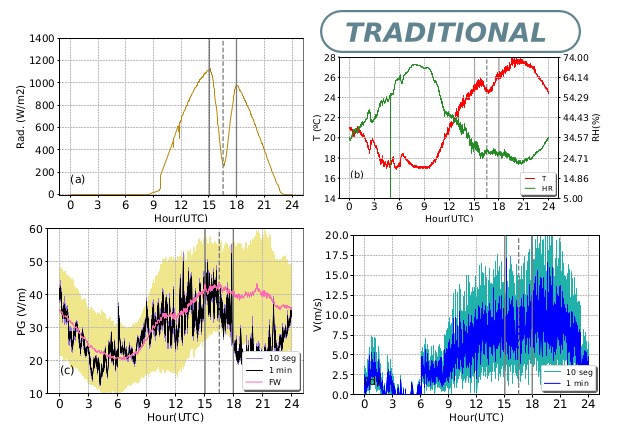The 2020 Patagonian solar eclipse from the point of view of the atmospheric electric field
DOI:
https://doi.org/10.4279/pip.140008Keywords:
Potential Gradient, Solar Eclipse, Atmospheric electric fieldAbstract
In this study, the response of atmospheric electrical and meteorological variables at three different sites of Argentina are studied during the total solar eclipse of December 14, 2020: Valcheta (100% darkening), Buenos Aires (73%) and El Leoncito (71%). The reduction in
solar irradiance caused by the solar eclipse was expected to directly affect the near-surface electric field, known as the potential gradient (PG), through a reduction in turbulence and an increase in air conductivity. From the analysis of the observed meteorological
parameters (temperature, relative humidity, and wind), no effects on the PG were observed that can be unequivocally attributed to this event based solely on boundary layer dynamics. The prevailing synoptic situation altered the response that the boundary layer could have given, namely, a clear drop in radiation, particularly at Valcheta, which was very close to a frontal zone and had occasional cloud coverage and reports of atmospheric suspended dust. PG measurements at Valcheta during the eclipse showed PG values several orders
of magnitude higher and of opposite sign to the global daily mean fair weather (FW) PG curve and the local FW-PG curves calculated at CITEDEF (940 km away) and CASLEO (1200 km away). The PG values at Valcheta were shown to be more closely related to disturbed weather conditions than FW. On the contrary, at the other two locations studied, CITEDEF and CASLEO, further north and more distant from the frontal zone, the observed PG values on the day of the eclipse showed a higher consistency with the local daily mean FW-PG curves. A comparison between the FW-PG local curves at these two sites and the evolution of PG during the day of the eclipse, however, reveals a drop in PG values during the eclipse.

Downloads
Published
How to Cite
Issue
Section
License
Copyright (c) 2022 Yasmin R. Velazquez, M. Gabriela Nicora, Victoria S. Galligani, Elian A. Wolfram, Facundo Orte, Raúl D'Elia, Sebastián Papandreas, Federico Verstraeten

This work is licensed under a Creative Commons Attribution 4.0 International License.
Authors agree to the PIP Copyleft Notice













